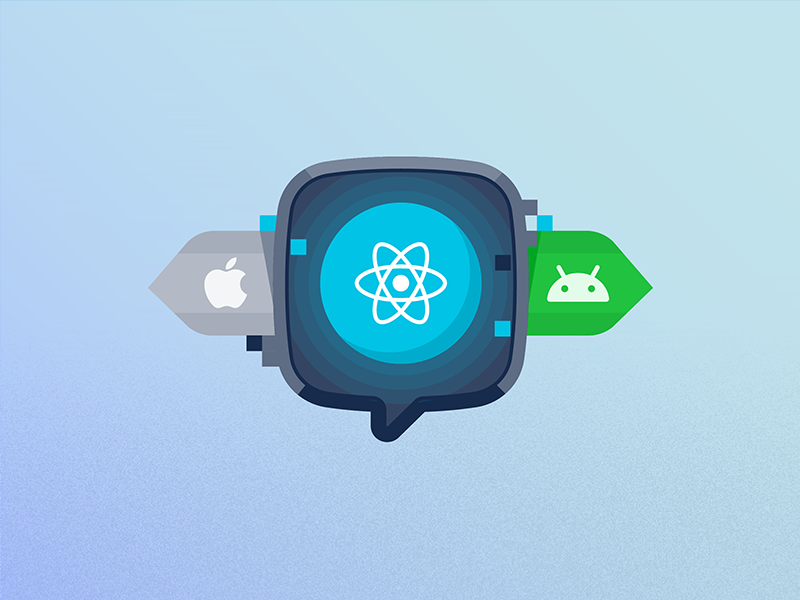Nowadays, the popularity of mobile applications is touching the sky. Companies are searching for options that offer great speed in the combination of fewer resources. To retain the competition in the market, companies prefer to adopt cross-platform solutions on native ones. This technology builds applications for both IOS and Android using a single language that is creating a buzz in the market. The organizations are looking for a flutter or react native development company to develop such apps. But to make this procedure more clear, let’s see which technologies among the Flutter and React Native is advantageous to prefer from a business perspective.
What is Flutter?

Though Flutter is a newbie in the crowd of multiplatform development toolsets, it is considered to be one of the best choices among many others. It is written in Dart. Before its release, it went through a beta-testing for a duration of about a year and thereafter, this framework became immensely popular with the Google launch in Dec 2018. In a very less time period, it already brags apps for Tencent, Reflects, etc. It is a visually attractive, portable UI toolkit for web, mobile, and desktop- using only one codebase.
What is React Native?

React Native is an open-source framework for mobile applications. It was created by Facebook that uses JavaScript. It is well-established and provides extensive features such as reliability. More frequently used cross-platform mobile apps like Pinterest, Uber, Wix, and Skype are created with the help of this framework. However, one should not overlook the fact that many users are switching to native app development toolsets.
| FLUTTER | REACT NATIVE |
| Stable android | Mobile and web shared development |
| Free, open-source | Cross-platform development |
| It uses Dart-an OOP language | It is based on JavaScript |
Read More: Why Flutter Holds The Future of Android App Development?
Pros and Cons of Flutter:

Pros of Flutter:
Faster Coding
More often it happens that developers make some changes in the code and expect it to reflect in the application as rapidly as possible. Flutter offers the hot reload feature which eventually supports the dynamic and faster app development. Hot Reload comes handy and helps the team members to fix the bugs, add more features, and instant experiment with new and creative ideas.
One Codebase, Different Platforms
Flutter requires just a single codebase for two different applications including IOS and Android platforms. It provides the ease to access the same app on different platforms as it possesses its own designs and widgets.
Smooth Performance
Flutter apps work smoothly and fast without hindering your scrolling. It uses Skia Graphics Library. It has the capacity to deliver 60 frames per second. Whenever a view changes, the UI is redrawn. It must be taken care that only certain elements that change must be redrawn otherwise it would affect the performance of the app.
Flattering Designs
Flutter gives the advantage of creating widgets or customizing an existing widget. It does not rely upon the components of the native system. It owns a friendly user interface and attracts the attention of developers with its visual details.
Cons of Flutter:
- As Dart is not as acceptable as JavaScript, it lacks a well-established community of developers.
- The existing libraries are not enough and rich as native development. In that case, it requires building custom functionality which consumes more time.
- The size of applications written in Flutter is bigger than those written on native platforms.
Pros and Cons of React Native:

Read More: Why React Native is the Ideal Framework for Building MVP Apps?
Pros of React Native:
- Along with hot reloading, the team of React Native included a new feature of the 0.61 version that supports fast refreshing. It is more adaptable to mistakes and initiates faster coding than the earlier version.
- The business logic behind the mobile web app, a native app, and a web desktop app is all the more same but requires a particular UI that fits the user requirements accordingly.
- This framework is widely popular because it uses JavaScript which is well-known among developers.
- React Native allows the user to make a distinct choice for the solutions they want to use.
- It has an active and vast community that includes numerous tutorials, UI frameworks, and libraries that makes it easy to learn the technology.
- Since the same test can run on two different platforms, we require 50% fewer automated tests to write them.
Cons of React Native:
- Just like any other cross-platform network, the experience does not match as in the native apps. With react native, it is somewhat possible to reach closer to that native performance but Flutter requires additional work.
- Additional components for React Native consumer more time and effort while Flutter supports a much number of widgets that saves time.
- React Native supports a large number of libraries. Out of which, many of them are either abandoned or of low quality.
- Every OS UI update instantly upgrades the app components as well whereas, Flutter has a stable application UI.
- Androids don’t have JavaScript Virtual Machine. In order to include such a library to be able to run the JavaScript code, the corresponding apps get bigger in size.
Comparison: React Native vs Flutter
- Despite a longer presence of React Native in the market, its documentation is not as much inviting as Flutter.
- The number of issues tackled by Flutter is more than React Native.
- Flutter is more like a full-stack framework than React Native.
- Flutter has an upper hand in performance when compared to React Native.
- Dart is difficult to learn for users who are familiar with JavaScript.
- The components of React Native cannot be customized always. It is like a wrapper over native methods that requires a medium to translate calls into a native API.
- The lack of platform constraints is the prime advantage delivered by Flutter
You May Also Like: Flutter for Web App Development
Final Thoughts: Flutter vs React Native
Currently, React Native covers mobile and web platforms- or everything that runs on a browser. Meanwhile, Flutter is striving hard to do the same, while some developers consider that it is not yet production-ready. Being the closest competitor to Flutter, React Native is setting the bar. In a couple of years, things will turn around but for now, if you are willing to perform in enterprise mobile application development React Native is there to your rescue.







